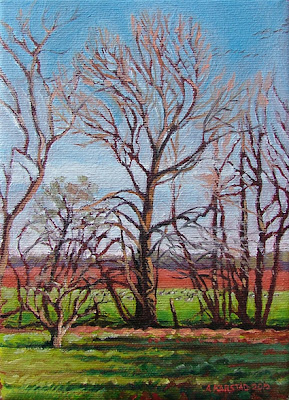Red Soil and Spring Green (oil on canvas 5 x 7 in.) Sold
28 April finds me sitting at the edge of an apple orchard, painting bands of red and green through a screen of fencerow trees north of Russell, Ontario. It's exciting to see the colour of the soil in these high fields near the old quarry of Queenston Shale, and I'm taking this opportunity to paint it before it grows up in crops. A Pine plantation on my right sends long shadows across the lush spring grass and the evening sun highlights Ash and Elm with rich ochres.
A flock of Canada Geese is resting on the green field beyond the fencerow. Now they stretch their necks and raise clamorous voices in greeting to geese in the air. Out of the empty blue, ragged scraps of a flock grow from a faint smudge to delicate pencil ticks, oriented like fine iron filings, scattered but responding to a force that pulling them in a sweeping curve to join their fellows on the green field.
Two massive-trunked Ash trees stand at the forest edge. Taking a break from my painting I
help Fred to measure the nearest of the big Ashes - over a metre in diameter! Robins begin their evening song, voices echoing through the Red Pines from thicker Spruce woods. Each phrase is followed by an affirmative "check" as if asserting the verity of the comment.I hear Fred's progress coming back through the Spruces, crashing like a lame bear. Emerging, he comments on the difficulty of forcing his way between 30 year old Spruces with intertwined branches, and shows a nice selection of small land snails and grey Arion slugs. Before 1981 this woodlot was scattered Sugar Maples in a pasture. Now the planted Red Pines are almost a foot through.The forest floor is mostly dry leaf litter in there, with dense patches of Violet and Trout Lily leaves and one patch of blooming Spring Beauty. The first few native spring ephemerals are expanding in the slow process of turning the plantation into a forest.





I don't normally think of shale as being red. This has a lot of iron in it?
ReplyDeleteThe top answer via google is "The clay and mud forming the future shale was eroded from a mountain range that was rich in iron minerals, roughly 400+ million years ago, thus the red color." - http://wiki.answers.com/Q/Why_is_Queenston_Shale_of_the_Niagara_Escarpment_red
ReplyDeleteYes, it does have lots of iron - about 6% iron content! This is the lower, red level of the Ordovician deposit of Quenston Shale, which shows red beneath the grey limestone and shale of the Niagara Escarpment, and also visible in the Rochester area of northern New York State. It makes dense brick of a bright red colour, and a quarry in Russell operated through most of the 1900's. The brickmaking industry there closed in the 1950's, but shale was being hauled from the quarry to a factory in Leitrim on the southern edge of Ottawa at least until the mid 1980's. The quarry is now closed and the land is owned by a developer who hopes to establish a megadump - in shale?
ReplyDelete